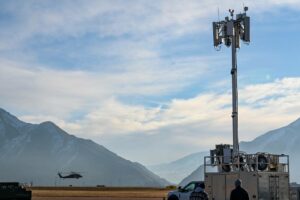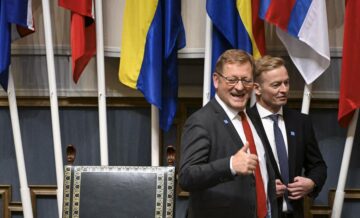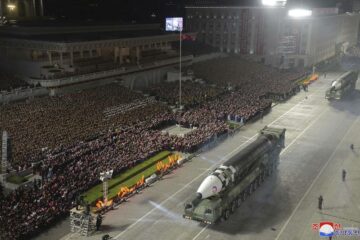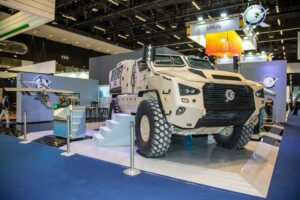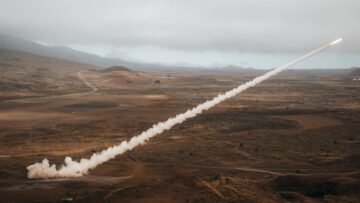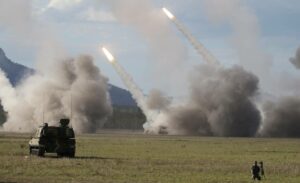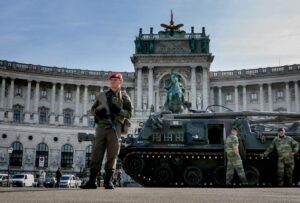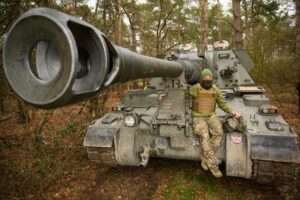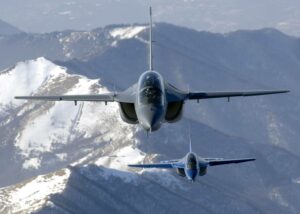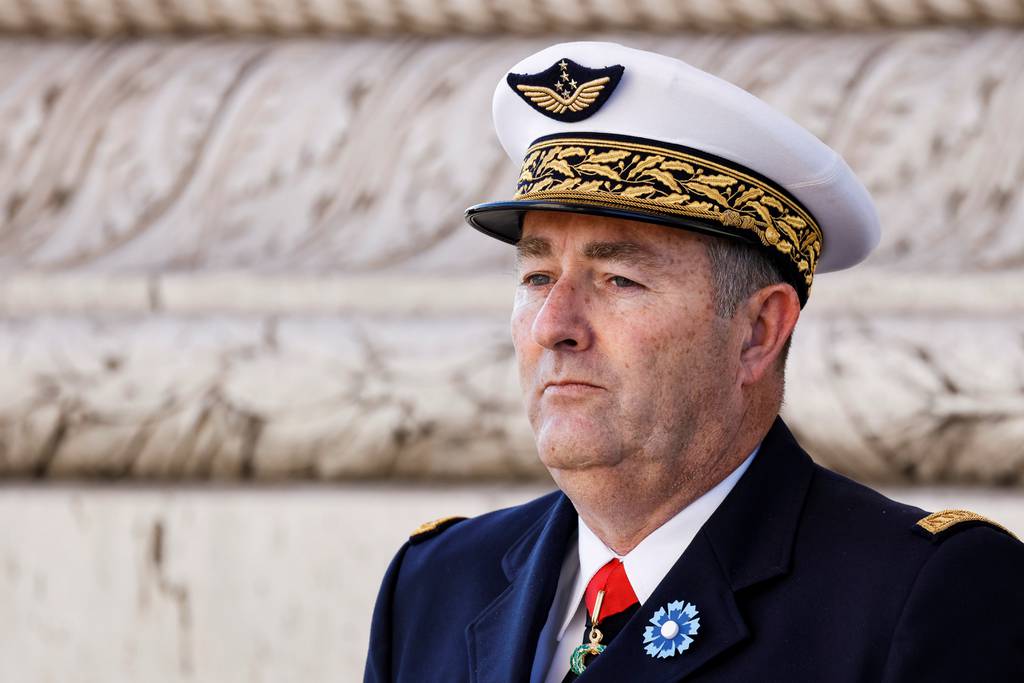
STUTTGART, Germany — Ahead of the first Paris Air Show since the pandemic began in 2020, France’s Air and Space Force chief of staff is shedding light on what attendants might take away from the event, which runs June 19-25.
In a June 8 interview with Defense News, Gen. Stéphane Mille noted the three air chiefs from Germany, France and Spain intend to sign a joint document outlining “the doctrinal approach of collaborative air combat” as the three nations pursue the next-generation Future Combat Air System program.
Many will likely visit the inaugural FCAS pavilion on the salon floor to find out if there are any updates on the program, which has suffered delays amid industry workshare disputes. Mille has said a demonstrator fighter aircraft is expected in 2029, two years later than originally scheduled.
The general also discussed the French military’s efforts toward an all-Rafale fighter fleet, lessons learned from Russia’s war in Ukraine, France’s defense space strategy and more. This interview was edited for length and clarity.
Now that Phase 1B of the Future Combat Air System program — known in France as SCAF — has begun, what are your expectations for future milestones and related work over the next few years before a demonstrator takes flight? How will the French Air and Space Force contribute to the program in the meantime?
Phase 1B was formalized on April 28 this year in Madrid, Spain, and is scheduled to end in 2025. This phase will usher in the final architecture for the SCAF, which encompasses the full spectrum of the fighter capabilities, including for instance its maneuverability, its stealth and its power. Then Phase 2 will take over and ultimately lead to a demonstration platform in 2029.
One thing to remember is that the Future Combat Air System is a system of systems including the Next Generation Weapon System but also other systems and collaborative sensors in the right environment.
The Next Generation Weapon System is structured around a new-generation fighter teaming with unmanned platforms and semiautonomous remote carriers within a broader, interconnected environment or system, constituting a system of systems alongside a combat cloud.
An issue to consider is the exact definition of remote carriers. I am thinking of their size, their functions and their level of connectivity.
It is important to note that during the Paris Air Show, the three air force chiefs from France, Germany and Spain will sign a joint document on the doctrinal approach of collaborative air combat. It is worth remembering that collaborative air combat is a form of combat within which the capabilities of the constitutive weapon systems are mutually reinforced. This reinforcement occurs throughout the whole array of elementary functions of combat — detecting, classifying, decision-making, engaging/firing, risk assessing — in order to secure a unique performance capability exceeding that of all the systems working in isolation.
Thereby, the very notion of collective effectiveness outweighs that of a better individual performance, including between mixed systems, and whatever the warfighting domain.
Among other concepts, collaborative combat was based both on a system-of-systems approach and on that of a combat cloud. In this respect, collaborative combat both allows for and requires the processing of primary data to generate shared and contextualized knowledge with a higher success rate.
As you can imagine, our service, thanks to a dedicated SCAF team in the Armed Forces Ministry’s headquarters, has been continuously committed to the program with our allies. Staff work has never stopped, and in the short term it’s only going to increase.
As France moves toward an all-Rafale fighter fleet by the mid-2030s, what is the legacy of the Mirage 2000? What will become of the remaining Mirage fighters that remain in good shape after retirement?
You are correct that in the near future, one of the French Air and Space Force objectives is to move toward an all-Rafale fighter fleet. But this will take time to achieve.
Firstly, 48 of our Mirage 2000D aircraft will be updated, improving their air-to-air capabilities. When their retirement happens, their legacy will keep fueling the Rafale community. In fact, culture being a cumulative addition of knowledge through time, the Rafale squadrons inherit techniques, tactics and procedures from previous pilots and engineers.
Getting airborne in 15, seven or even two minutes for a live scramble, bombing at low, medium or high altitude, flying very low and very fast at day and night, are part of French pilot heritage and savoir faire. Hence, Rafale squadrons will keep enhancing readiness, endurance and air power thanks to the Mirage 2000′s legacy.
For the remaining Mirage 2000 aircraft post-retirement, there is no decision at the moment as to their potential future exploitation — an adversarial role in training, export or otherwise.
How is the service beginning preparations for an eventual Rafale-SCAF fleet starting in the 2040s?
The service is preparing by thinking about the best military tool for the wars of tomorrow. By doing so, we are working on developing ubiquity by proxy through a more systematic use of drones and remote carriers to fight along with manned aircraft such as the Rafale.
An active, collaborative effort with multiple functions — reconnaissance, targeting, electronic warfare and so on — between varied Rafale, next-generation fighters and remote carriers will guarantee a better synchronization of effects, and thus take the enemy by surprise.
The Rafale will play a role in this enhanced strategy, this system of systems. It will help progressively to adopt a multidomain perspective via its sensors in order to maximize joint military forces.
However, the key aspect for an effective, connected, collaborative air combat system is the command and control. Success will be achieved via a progressive transformation of C2 toward evolving command structures capable of allotting responsibilities in a more dynamic fashion and within a closer range if needed in order to secure the continuity of the chain of command — and in doing so, to guarantee a better adapted response to a specific context.
What are your observations from Russia’s war against Ukraine in terms of the air and space domains — for example, drone use and GPS jamming? How will the service reflect those lessons in its spending priorities?
There was something that we didn’t really see at first, but which is critical for air power: The Russian Aerospace Forces, or VKS, were unprepared, not effectively employed, with an absence of an air campaign plan, with a command structure that was very rigid compared to that of the Ukrainians, which was more agile.
This war reminds me of a specific point that I mentioned in my strategic vision back in 2021: the utmost importance of “suppression of enemy air defenses,” or SEAD, missions.
Air superiority relies on two fundamental and complementary pillars: air combat superiority and neutralization of our enemies’ ground-to-air defense systems. A SEAD capability is essential to ensure the coherence and freedom of our action in a contested environment.
Starting in a period of “competition,” SEAD requires an in-depth knowledge of our enemy’s means and organization. Once the fighting phase has begun, we have to be able to neutralize these systems by jamming or destroying them.
Improvements have to be made to our existing capabilities to reinforce this domain.
Ukraine’s war is a war of position; it resembles a war of the past. With a real air campaign and a better use of air power, the situation on the ground would have been settled more quickly. Air power is decisive when it’s well employed.
Finally, this war highlights the innovative, agile and efficient Ukrainian command and control; the importance of satellite communications and the irruption of space commercial assets; and a significant increase in the use of low-cost drones, albeit without a tactically or strategically decisive impact.
France’s space strategy contains an explicit nod to the maneuverability of space assets, including manipulating potentially hostile satellites. What does that mean, and what types of technologies could come into play to realize this?
As a space power for several decades, France identified the extra-atmospheric environment early on as a structuring factor of its power — essential to its autonomy for assessing situations, making decisions and taking action. It chose to make these efforts part of a long-term strategy. From this point of view, the French Space Defence Strategy edited in 2019 was a turning point in the history of our defense space policy, without breaking from the past.
One of the aims underlined by this document is to develop, perpetuate and improve our military strategic intelligence as well as operations-support capabilities, while at the same time strengthening our ability to understand and continuously monitor activity in all orbits of interest autonomously, and by 2030 providing us with an active-defense space capability to be able, should the need arise, defend our interests in strict compliance with international laws, including self-defense.
In parallel, France is working with its allies to promote a pragmatic approach based on norms of responsible behavior designed to counter destabilizing actions and ensure the peaceful use of space.
While France must have credible autonomous capabilities for situation assessment, decision-making and action, it also needs to act cooperatively. In this respect, mobilizing capable and willing partners is more essential than ever. France is therefore involved in multilateral and bilateral cooperation, in particular with the European Union and the initiative called Combined Space Operations.
France hosted the Orion exercise with NATO allies, focusing on the land, air, sea and cyberspace domains. What are the lessons learned following the drill?
The lessons learned are still being collated, as Orion only ended a couple of weeks ago. We need time to gather and analyze information and feedback from this huge exercise — a unique one in the last 30 years.
A hot debrief from our perspective is that the number of fighter sorties during Orion’s fourth phase was impressive: 700 in two weeks.
Orion was of significant importance in terms of global effort and commitment for our aviators in parallel with our daily missions, and in addition to Operation Sagittaire, the evacuation of multinational civilians from Sudan in light of the ongoing crisis.
Another lesson learned during Orion was the necessity to have a coherent, multidomain C2 structure, enabling communication between different components.
The second area addressed during Orion’s second phase was the space domain. France’s Space Command, or CDE, organized the AsterX military space exercise, unique in Europe, on the National Centre for Space Studies site in Toulouse. The novelty this year was its full integration into the second phase.
Consequently, CDE units trained in a simulated but realistic and complex environment, dealing with emerging and increasingly varied threats. About 5,000 space objects were simulated over the two weeks in multidomain environments, providing an opportunity to test the interoperability between C2 for military space operations and the other command structures.
With a view to bolstering operational cooperation in space, some 200 American, German, Italian and Belgian service personnel took part in the different simulations.
Ultimately, Orion revealed the very real need and importance in the role of the space domain in modern military operations. Our space capabilities and assets support all our operations, whether in terms of observation, telecommunications, tapping or navigational aid. As an integral part of the joint force military operations, space structures make the intelligence they collect available to the different operational commands.
Vivienne Machi is a reporter based in Stuttgart, Germany, contributing to Defense News' European coverage. She previously reported for National Defense Magazine, Defense Daily, Via Satellite, Foreign Policy and the Dayton Daily News. She was named the Defence Media Awards' best young defense journalist in 2020.
- SEO Powered Content & PR Distribution. Get Amplified Today.
- EVM Finance. Unified Interface for Decentralized Finance. Access Here.
- Quantum Media Group. IR/PR Amplified. Access Here.
- PlatoAiStream. Web3 Data Intelligence. Knowledge Amplified. Access Here.
- Source: https://www.defensenews.com/interviews/2023/06/15/six-questions-with-frances-air-and-space-force-chief/
- :has
- :is
- :not
- 000
- 1
- 10
- 14
- 15%
- 1b
- 1st
- 200
- 2018
- 2019
- 2020
- 2021
- 2023
- 2025
- 2030
- 22
- 28
- 30
- 70
- 8
- 9
- a
- ability
- Able
- About
- Achieve
- achieved
- Act
- Action
- actions
- active
- activity
- adapted
- addition
- adopt
- adversarial
- Aerospace
- After
- against
- agile
- ago
- ahead
- Aid
- aims
- AIR
- Air Force
- air-to-air
- aircraft
- Alexa
- All
- allows
- along
- alongside
- also
- am
- American
- Amid
- an
- analyze
- and
- any
- approach
- April
- architecture
- ARE
- AREA
- armed
- around
- Array
- AS
- aspect
- Assessing
- assessment
- Assets
- At
- Attendants
- autonomous
- autonomously
- available
- aviation
- awards
- away
- back
- based
- BE
- become
- been
- before
- began
- Beginning
- begun
- being
- BEST
- Better
- between
- both
- Breaking
- broader
- but
- by
- called
- Campaign
- CAN
- capabilities
- capable
- carriers
- centre
- chain
- chief
- chose
- civilians
- clarity
- closer
- Cloud
- COHERENT
- collaborative
- collect
- Collective
- combat
- combined
- come
- commercial
- commitment
- committed
- Communication
- Communications
- compared
- complementary
- complex
- compliance
- components
- concepts
- connected
- Connectivity
- Consider
- contains
- context
- continuously
- contribute
- contributing
- control
- cooperation
- correct
- could
- Counter
- Couple
- coverage
- credible
- crisis
- critical
- Culture
- cyberspace
- daily
- Daily news
- data
- day
- dealing
- Debrief
- decades
- decision
- Decision Making
- decisions
- decisive
- dedicated
- defence
- Defense
- delays
- designed
- develop
- developing
- Development
- different
- discussed
- Display
- disputes
- document
- does
- doing
- domain
- domains
- drone
- Drones
- during
- dynamic
- Early
- Effective
- effectively
- effectiveness
- effects
- efficient
- effort
- efforts
- Electronic
- emerging
- employed
- enabling
- encompasses
- end
- Engineers
- England
- enhanced
- enhancing
- ensure
- Environment
- environments
- essential
- Europe
- European
- european union
- Even
- Event
- eventual
- EVER
- evolving
- example
- Exercise
- existing
- expectations
- expected
- exploitation
- export
- fact
- factor
- Fashion
- FAST
- Feb
- feedback
- few
- fight
- fighters
- fighting
- final
- Find
- First
- FLEET
- flight
- Floor
- flying
- focusing
- following
- For
- Force
- Forces
- foreign
- foreign policy
- form
- Fourth
- France
- Freedom
- French
- from
- full
- full spectrum
- functions
- fundamental
- future
- gather
- Gen
- General
- generate
- generation
- German
- Germany
- Global
- going
- good
- gps
- Ground
- guarantee
- happens
- Have
- Headquarters
- help
- hence
- heritage
- High
- higher
- highlights
- history
- HOT
- How
- HTTPS
- huge
- i
- identified
- if
- image
- images
- imagine
- Impact
- importance
- important
- impressive
- improve
- improving
- in
- in-depth
- Inaugural
- Including
- Increase
- increasingly
- individual
- industry
- information
- Initiative
- innovative
- instance
- integral
- integration
- Intelligence
- intend
- interconnected
- interest
- interests
- International
- Interoperability
- Interview
- into
- involved
- isolation
- issue
- IT
- Italian
- ITS
- Jan
- joint
- journalist
- jpg
- june
- Keep
- Key
- knowledge
- known
- Land
- Last
- later
- Laws
- lead
- learned
- Legacy
- legion
- Length
- lesson
- Lessons
- Lessons Learned
- Level
- light
- likely
- live
- long-term
- Low
- low-cost
- machi
- made
- magazine
- make
- Making
- manipulating
- Marine
- Maximize
- mean
- means
- meantime
- Media
- medium
- meeting
- mentioned
- might
- Milestones
- Military
- minutes
- Mirage
- missions
- mixed
- model
- Modern
- moment
- Monitor
- more
- move
- moves
- multilateral
- multinational
- multiple
- must
- mutually
- my
- Named
- National
- Nations
- Near
- Need
- needed
- needs
- never
- news
- next
- next-generation
- night
- no
- noted
- Notion
- novelty
- number
- objectives
- objects
- of
- on
- once
- ONE
- ongoing
- only
- operation
- operational
- Operations
- Opportunity
- or
- order
- organization
- Organized
- originally
- Other
- otherwise
- our
- out
- over
- Palace
- Parallel
- paris
- part
- particular
- partners
- past
- perform
- performance
- period
- Personnel
- perspective
- phase
- pilot
- Pilots
- plan
- platform
- Platforms
- plato
- Plato Data Intelligence
- PlatoData
- Play
- Point
- Point of View
- policy
- position
- potential
- potentially
- power
- pragmatic
- preparing
- president
- presidential
- previous
- previously
- primary
- procedures
- processing
- Program
- progressive
- progressively
- promote
- providing
- proxy
- pursue
- Questions
- quickly
- range
- Rate
- Readiness
- real
- realistic
- realize
- really
- receive
- reflect
- reinforce
- related
- remain
- remaining
- remember
- remembering
- remote
- Reported
- reporter
- requires
- resembles
- respect
- response
- responsibilities
- responsible
- retirement
- Revealed
- right
- rigid
- Risk
- Role
- russian
- s
- Said
- same
- satellite
- satellites
- scheduled
- SEA
- Second
- secure
- see
- sensors
- service
- Settled
- seven
- several
- Shape
- shared
- she
- Short
- should
- show
- sign
- significant
- since
- site
- situation
- situations
- SIX
- Size
- So
- some
- something
- Space
- Space Force
- Spain
- specific
- Spectrum
- Spending
- Staff
- Starting
- Stealth
- Still
- stopped
- Strategic
- Strategically
- Strategy
- strengthening
- strict
- structure
- structured
- structuring
- studies
- success
- such
- Sudan
- support
- surprise
- synchronization
- system
- Systems
- tactics
- Take
- takes
- taking
- targeting
- team
- techniques
- Technologies
- telecommunications
- term
- terms
- test
- than
- thanks
- that
- The
- The Future
- The Initiative
- the joint
- their
- Them
- then
- There.
- therefore
- These
- they
- thing
- Thinking
- this
- this year
- those
- threats
- three
- Through
- throughout
- time
- to
- tomorrow
- took
- tool
- Tour
- toward
- trained
- Training
- Transformation
- Turning
- turning point
- two
- types
- Ukraine
- Ukrainian
- Ukrainians
- Ultimately
- understand
- union
- unique
- units
- updated
- Updates
- us
- use
- very
- via
- View
- vision
- Visit
- war
- was
- we
- Weeks
- WELL
- were
- What
- What is
- whatever
- when
- whether
- which
- while
- whole
- will
- willing
- with
- within
- without
- Work
- working
- worth
- would
- year
- years
- you
- young
- Your
- zephyrnet

